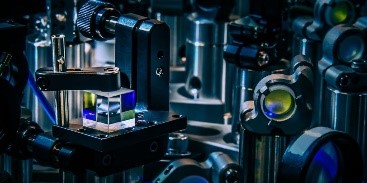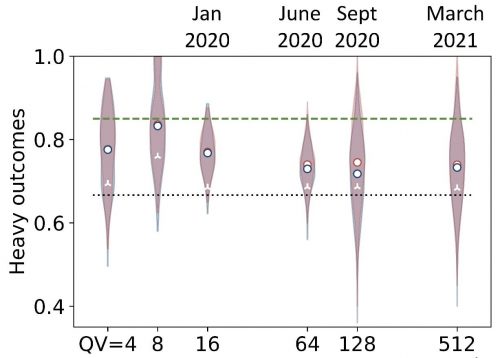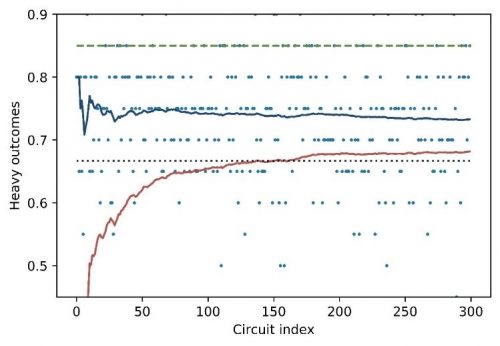Honeywell Quantum volume Solutions has achieved another milestone in its quest to develop the highest-performing quantum computers on the market.
This week, the System Model H1 quadrupled its performance in terms of quantum volume and became the first commercial quantum computer to measure 512. It marks the third time in nine months Honeywell has set an industry record for quantum volume.
“It’s a remarkable accomplishment when you consider we launched our first commercial technology less than a year ago,” said Tony Uttley, president of Honeywell Quantum Solutions. “The System Model H1 is once again the highest performing quantum computing system in the world.”
What it took
Honeywell set a record in June 2020 when it unveiled its first commercial system. The System Model H0 achieved a quantum volume of 64, double the measure of any other systems available at that time.
A few months later, Honeywell surpassed that record when it released its second commercial technology. The System Model H1 attained a quantum volume of 128 in September, making it the highest performing quantum computer in the world.
The Honeywell team has spent the months since working with commercial customers such as BMW, DHL, JP Morgan Chase, and Samsung on projects and making upgrades to the System Model H1.
“We learned a lot by running projects for customers and then taking the time to refine operations,” Uttley said. “By providing a workspace for our partners to explore and push the bounds of what is possible, we were able to make improvements to the hardware and eventually quadruple our quantum volume.”
What it means
The concept of quantums volume emerged a few years ago as developers and users grappled with how to evaluate the performance of the myriad quantum hardware technologies and their varying levels of operational fidelity.
Quantums volume is a measurement that requires a complex set of statistical tests. A variety of factors influences the results, including the number of qubits, error rates, connectivity of qubits, and cross-talk between qubits.
With its industry-leading quantums operation fidelities and all-to-all connectedness of the qubits present in the system, Honeywell’s trapped-ion technology performs highly in this metric even though it has fewer physical qubits than many other commercial systems. (The System Model H0 has 6 and the System Model H1 currently has 10 qubits.)
What’s next
Honeywell will continue to push toward higher quantum volumes, but also is focused on eliminating errors and improving accuracy of its systems, Uttley said.
“All of these are important if quantum computers are to successfully tackle problems that are impossible with classical computers,” he said.
See how we did it:
Honeywell sets new record for Quantum Computing Performance
System Model H1 becomes first commercial system to achieve a quantum volume of 512 benchmark
Honeywell Quantums Solutions’ streak of setting new records for quantum volume continues.
Through performance upgrades, System Model H1 achieved a quantum volume of 512, the highest measured on a commercial quantums computer to date. It is the third time in nine months Honeywell has set a record for quantum volume on one of its systems.
The milestone represents a four-fold increase in performance for the System Model H1, which set a record when it was released in September 2020 with a quantum volume of 128.
This high performance, combined with low error mid-circuit measurement, provides unique capabilities with which quantum algorithm developers can innovate.
How we did it
The System Model H1 operations have continued to improve since it was first released.
The average single-qubit gate fidelity for this milestone was 99.991(8)%, the average two-qubit gate fidelity was 99.76(3)% with fully-connected qubits, and measurement fidelity was 99.75(3)%. We ran 300 circuits with 20 shots each, using standard QV optimization techniques to yield an average of 76.82 two-qubit gates per circuit.
The System Model H1 successfully passed the quantum volume 512 benchmark, outputting heavy outcomes 73.32% of the time, which is above the 2/3 threshold with 99.54% confidence.
The plot above shows the heavy outcomes for Honeywell Quantum Solutions’ tests of quantum volume and the dates when each test passed. All tests are above the 2/3 threshold to pass the respective Quantum Volume. Circles indicate heavy outcome averages and the violin plots show the histogram distributions. Data colored in blue show system performance results and red show modeled, noise-included simulation data. White markers are the lower 2-sigma error bounds.
The plot above shows the individual heavy outcomes for each Quantum Volume 512 run. The blue line is an average of heavy outcomes and the red line is the lower 2-sigma error bar which crosses the 2/3 threshold after 151 circuits.
Honeywell’s quantum systems are accessible directly and through ecosystem partner platforms, including Microsoft’s Azure Quantums, Cambridge Quantum Computing’s tket, Zapata Computing’s Orquestra, and the Strangeworks QC platform. In addition to offering high-fidelity, fully connected qubits, our system features a unique mid-circuit measurement capability, which enables users to explore new classes of algorithms and to greatly reduce the number of qubits needed for certain algorithms.
The post Quantum Milestone: How We Quadrupled Performance appeared first on ELE Times.



No comments:
Post a Comment